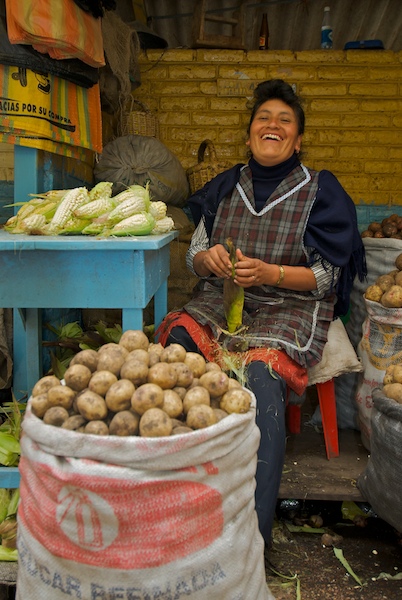
The Tip
As a travel writer and photographer, I’m often asked about tipping. Do you tip? How much in France? How much in Africa? For what services? Professionally, I divide tipping into two categories; photography and everything else.
Photography
Let’s start with photography. At my photo workshops I often instruct people not to tip to allow you to take a person’s photograph. I’m not saying this like I have the moral high ground. I know this is a difficult issue and why short-change a few shekels to someone who is making $25 a month, on a good month?Aside from the fact that tipping for photos just encourages everyone to ask for money, making all our photo efforts that much more difficult, in my personal opinion I do believe that tipping is insulting to those you photograph. It turns them into subjects/objects rather than real people with whom we can establish a genuine connection.
Here’s how I work. Let’s say I’m in a market, which is one of my favorite places to capture people in the context of their culture. I roam around, camera casually hanging from my shoulder. I meet people’s eyes. I talk to them. I smile a lot, not to curry favor, but because I’m usually thoroughly enjoying myself. I ask questions about their craft or children. I laugh at my poor language skills. I buy something. (I admit it also helps if I have my wife along. Her winning smile and joie de vivre somehow both attracts people and puts them at ease.)
Only after this “relationship-building” phase will I ask, either by word or gesture, if I may take their picture. I am rarely refused and I’ve never had to pay. There have been exceptions, but usually because I was rushed and didn’t follow my normal modus operandi. I find that in this way the subject feels respected. We’ve made a human connection.
If I’m in a rush and I snap a picture before asking for permission, I will delete it immediately if the person objects. Of course, as a pro, I have to have a signed permission form to use it in publications, so I carry cards, ready to hand out. Lately I use an app on my smart phone. I always show the resulting picture to the subject immediately, which is one of the joys of digital. I will also bring prints with me when I return to a spot or mail them to people when possible.
So much for photography tipping.
Everything Else
I know that the issue of tipping bothers some people. I mean really bothers them. Their argument is, why do I have to pay extra for good service? That should be expected. I agree. But tipping really is a mindset, and a form of travel etiquette.The reality of modern life is that the tip is the norm. Wait staff rarely make a living wage without it. Ditto with bellhops and a host of occupations, especially when traveling in developing nations. What I do I learned from traveling to dozens of countries on all continents.
In the USA I generally add 20% to pre-tax restaurant bills and 15% in Canada, more if the service is exceptional. At airports I give a buck for each bag to the driver who loads/unloads them onto the shuttle bus and at curbside check-in. In hotels, I always leave $3-5/day for the housekeeper. If I will be staying for more than a few days, I usually pull the weekday housekeeper aside, get her name, give her an upfront tip and tell her I’ll be giving her an additional tip if she takes exceptional care of our room. Works wonders, but has no effect on bedbugs!
In Europe, I generally tip 10-15%. Central and South America, 10-15%. In Africa the norm is 5-10%, although that appears to be increasing. In Egypt, for example, make sure that the tip is not included in the bill before adding one yourself.
Australia is 10-15% for me, but New Zealand really depends. It’s a much more independent minded people and they will sometimes refuse a tip. Be sensitive to that. Ask, but don’t force a tip on someone who is reluctant. A nice thank-you will do.
Most people experience Africa and Egypt, in particular (Egypt is considered north Africa), through guided tours. Here is where I get the most complaints, since tourists might spend $5,000-10,000 or more for a tour, so why do they have to tip over and above that? Get over it. Tips are expected for your guide, porters, housekeepers. Right from the get-go, adjust your mindset. It’s not a $10,000 trip; it’s an $11,500 trip.
The best way I have found to handle the correct amount is by asking the tour operator in advance what is the range of tip expected. Select your comfort level from within that range and give the people your tip directly, preferably the night before your last day. In many cases tips are all the compensation that person will get. Oh, and carry cash for the tip. Many of these workers do not have access to a bank and can’t cash a check.
On cruises, there are gratuity guidelines published by every cruise line. They even offer the option of signing up in advance for their standard tipping regime (or pencil in your own number) and having it auto-charged to your credit card. The staff is informed that you elected that option, although they do not know the exact amount. In general, plan for $15-20/day for gratuities that cover wait staff and housekeepers.
I like to think that my tipping conduct is a goodwill gesture advancing public opinion of Americans (or whatever your nationality) far more effectively than does our government’s policies. That’s my story and I’m sticking to it.